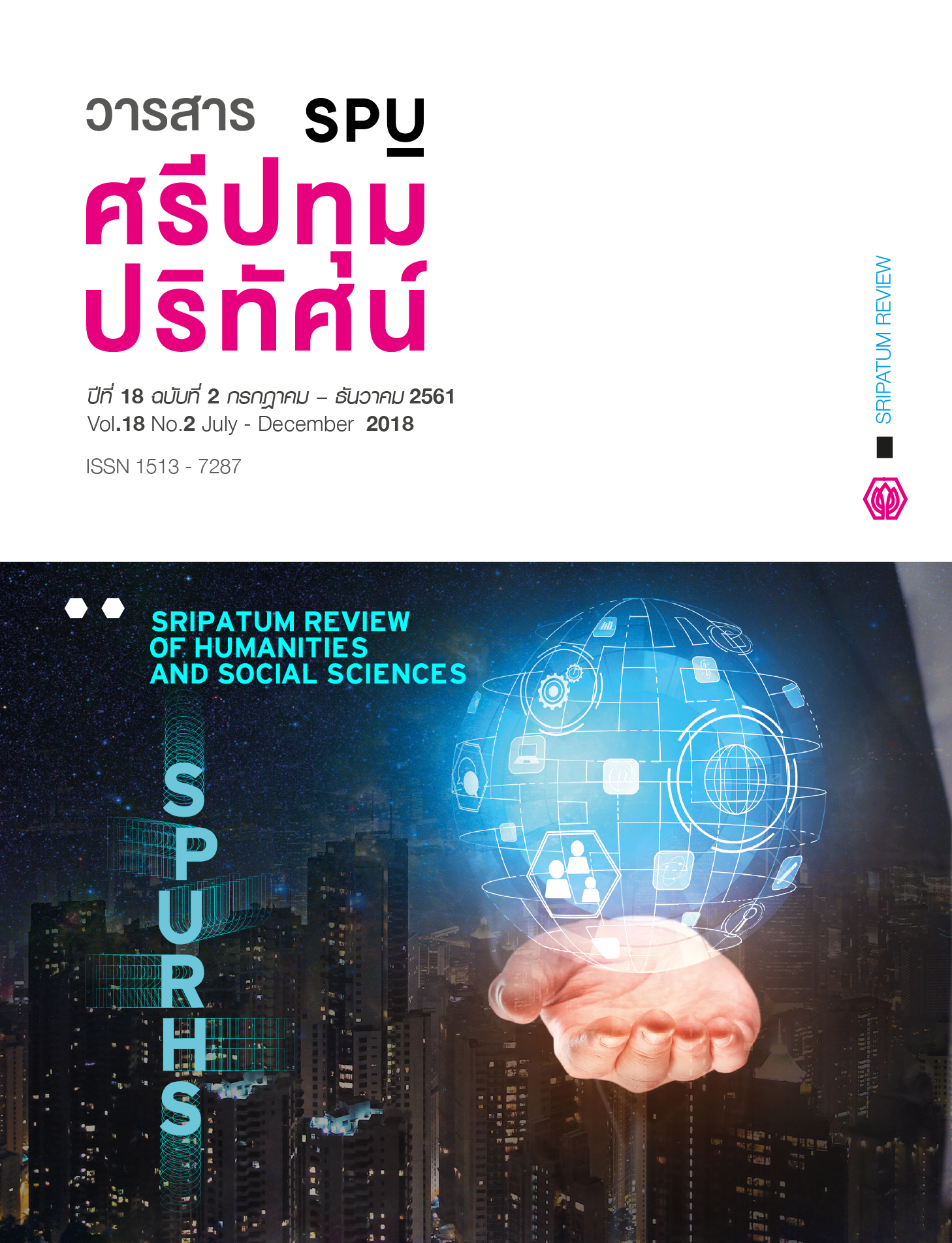THE CAUSAL MODEL OF FACTORS AFFECTING THAI CUSTOMER LOYALTY TOWARDS E-COMMERCE BUSINESS
Main Article Content
Abstract
The objectives of this research were (1) to develop a causal model of factors affecting Thai customer’s loyalty towards e-commerce business; and (2) to examine the goodness of fit of the causal model of factors affecting Thai customer’s loyalty towards e-commerce business with the empirical data. The research model consisted of 9 latent variables, namely, information quality, system quality, product and service quality, brand image, marketing communication tools, perceived value, satisfaction, trust, and loyalty. This research was a quantitative research employing the survey method. The research sample consisted of 360 Thai customers as respondents who shopped via e-commerce websites, obtained by the multi-stage sampling technique. An online questionnaire was employed as a tool for collecting data. Data were analyzed with the structural equation modeling (SEM). The results revealed that the causal model of factors affecting Thai customer’s loyalty towards e-commerce business developed in this research fitted with the empirical data at the statistical significance level of 0.001, 0.050, and 0.100. Also, the results of path analysis of variables in this model revealed that the system quality had direct effect on the customer’s perceived value of e-commerce business with a path coefficient of 0.485. The product and service quality had direct effect on the customer’s perceived value of e-commerce business and had direct effect on the customer’s satisfaction with e-commerce business with path coefficients of 1.650 and 1.287, respectively. The customer’s perceived value and the customer’s satisfaction had direct effects on the customer’s loyalty towards e-commerce business with path coefficients of 0.961 and 1.754, respectively. Finally, the customer’s satisfaction had direct effect on the customer’s trust in e-commerce business with a path coefficient of 0.827.
Article Details
1. กองบรรณาธิการสงวนสิทธิ์ในการพิจารณาและตัดสินการตีพิมพ์บทความในวารสาร
2. บทความทุกเรื่องจะได้รับการตรวจสอบทางวิชาการโดยผู้ทรงคุณวุฒิ แต่ข้อความและเนื้อหาในบทความที่ตีพิมพ์เป็นความรับผิดชอบของผู้เขียนแต่เพียงผู้เดียว มิใช่ความคิดเห็นและความรับผิดชอบของมหาวิทยาลัยศรีปทุม
3. การคัดลอกอ้างอิงต้องดำเนินการตามการปฏิบัติในหมู่นักวิชาการโดยทั่วไป และสอดคล้องกับกฎหมายที่เกี่ยวข้อง
References
กระทรวงเทคโนโลยีสารสนเทศและการสื่อสาร.2558. สำรวจการมีการใช้เทคโนโลยีสารสนเทศและการสื่อสารในครัวเรือนพ.ศ. 2558. สืบค้นเมื่อวันที่ 20 กันยายน 2559 .
ชัยวัฒน์ พิทักษ์รักธรรม. 2556. “ปัจจัยที่มีความ สัมพันธ์ต่อการตัดสินใจซื้อสินค้าของผู้บริโภค.” วิทยานิพนธ์ปริญญามหาบัณฑิต สาขาวิชาการจัดการ บัณฑิตวิทยาลัย มหาวิทยาลัยเทคโนโลยีราชมงคลพระนคร.
ชูชัย สมิทธิไกร. 2553. พฤติกรรมผู้บริโภค. กรุงเทพฯ: จุฬาลงกรณ์มหาวิทยาลัย.
ณัฐจักร์ ตรีสัตยาเวทย์. 2547. “การศึกษาเปรียบเทียบความคิดเห็นของผู้บริโภคต่อปัจจัยด้านการตลาดที่มีต่อร้านค้าปลีกทางอินเทอร์เน็ตและการค้าปลีกแบบมีร้านค้า.” รายงานการศึกษาอิสระปริญญามหาบัณฑิต สาขาวิชาการตลาด บัณฑิตวิทยาลัย มหาวิทยาลัยเชียงใหม่.
ยุทธ ไกยวรรณ์. 2556. การวิเคราะห์โมเดลสมการโครงสร้างด้วย AMOS. กรุงเทพฯ: จุฬาลงกรณ์มหาวิทยาลัย.
สมิต สัชฌุกร. 2550. การต้อนรับและบริการที่เป็นเลิศ. พิมพ์ครั้งที่ 5. กรุงเทพฯ: สายธาร.
สุวิทย์ เมษินทรีย์. 2558. แนวคิดเกี่ยวกับประเทศไทย 4.0. สืบค้นเมื่อวันที่ 18 กันยายน 2559 .
เสาวคนธ์ หอมสุต. 2557. “แบบจำลองสมการ โครงสร้างความตั้งใจซื้อซ้ำของลูกค้าต่อพาณิชย์อิเล็กทรอนิกส์ประเภท B2C ในเขตกรุงเทพมหานคร.” วิทยานิพนธ์ปริญญามหาบัณฑิต สาขาวิชาเทคโนโลยีสารสนเทศ บัณฑิตวิทยาลัย สถาบัน เทคโนโลยีพระจอมเกล้าเจ้าคุณทหารลาดกระบัง.
Anderson, R. E., & Srinivasan, S. S. 2003. “E-satisfaction and e-loyalty: a contingency framework.” Psychology and Marketing, 20 (2), 123-138.
Boulding, W., Ajay, K., Richard, S., & Valarie, A. 1993. “A dynamic process model of service quality: from expectations to behavioral intentions.” Journal of Marketing Research, 30 (2), 7-27.
Bridges, E., & Florsheim, R. 2008. “Hedonic and utilitarian shopping goals: the online experience.” Journal of Business Research, 61 (8),309-314.
Brotherton, B. 2004. “Critical success factors in UK budget hotel operations.” International Journal of Operations and Productions Management, 24 (9), 944-969.
Chang, H., Wang, W. H., & Yang, W. Y. 2009. “The impact of e-service quality, customer satisfaction and loyalty on e-marketing: moderating effect of perceived value.” Total Quality Management, 20 (4), 423-443.
Cyr, D. 2008. “Modeling website design across cultures: relationships to trust, satisfaction and e-loyalty.” Journal of Management Information Systems, 24 (4),47-72.
Gommans, M., Krishnan, K. S., & Scheffold, K. B. 2001. “From brand loyalty to e-loyalty: a conceptual framework.” Journal of Economic and Social Research, 3 (1), 43-58.
Hair, J. F., Black, W. C., Babin, B. J., & Anderson, R. E. 2010. Multivariate Data Analysis. 7th ed. Upper Saddle River: NJ Prentice Hall.
Kim, C., Galliers, R. D., Shin, N., Ryoo, J., & Kim, J. 2012. “Factors influencing internet shopping value and customer repurchase intention.” Electronic Commerce Research and Applications, 11 (3), 374-387.
Kim, J., Jin, B., & Swinney, J. L. 2009. “The role of etail quality, e-satisfaction and e-trust in online loyalty development process.” Journal of Retailing and Consumer Services, 16 (4), 239-247.
Moorman, C., Deshpande, R., & Zaltman, G. 1993. “Factors affecting trust in market research relationships.” Journal of Marketing, 57 (1), 81-101.
Mukherjee, A., & Nath, P. 2003. “A model of trust in online relationship banking.” International Journal of Bank Marketing, 21 (1), 5-15.
Reichheld, F. F., & Schefter, P. 2000. “E-loyalty: your secret weapon on the web.” Harvard Business Review, 78 (4), 105-113.
Yousafzai, S. Y., Pallister, J. G., & Foxall, G. R. 2003. “A proposed model of e-trust for electronic banking.” Technovation, 23 (11), 847-860.
Zeithaml, V. A., Parasuraman, A., & Malhotra, A. 2002. “Service quality delivery through web sites: a critical review of extant knowledge.” Journal of the Academy of Marketing Science, 30 (4), 362-375.


